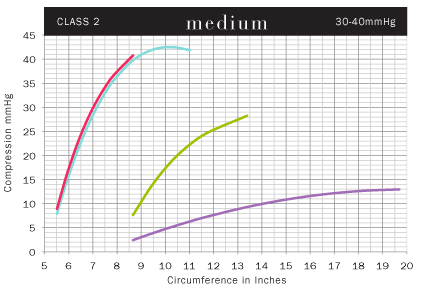Since our inception in 2006, we have been a customer service driven company. This ultimately means that we are not only interested in providing our customers with a garment they will actually want to wear, but also one that is sized and fitted to a higher degree of quality and precision than any other.
This is why, when customers have called with questions on how to determine sizing for their particular arm using the sizing chart, we listened and listened carefully. Calls would come in daily from customers who either fit in-between sizes or just weren’t sure which size they should wear. Our Chief Medical Officer, Dr. Levin didn’t want to rely on the sizing chart ranges to answer these critical question, instead he determined that a better approach would be to measure the delivered compression for a given circumference in all of our garments. With this information we would not only be armed to help those with questions but to also help better fit all customers.
With that notion, the idea of the Fitter’s Aid was born. First, we needed to do what no other manufacturer has done before: measure the delivered compression of our garments and open that information to the public. To do this, we purchased an industry standard Salzmann MST-MKIV compression tester. Next, we created cylinder forms of varying circumferences that would act as models for wrists, forearms and biceps. Although no one’s arm is shaped like a cylinder, using these forms enabled us to get an approximation of the pressure delivered that could be independently verified by anyone with the same equipment. Having these standard forms and the identified points along the garment for testing, we were able to obtain reproducible and verifiable pressures for the range of circumferences for each of the specified points for all our garments.

With this methodology Dr. Levin was able to create a curve showing the average pressure at the palm, wrist, forearm and bicep measurements and the corresponding circumferences at those points. These curves not only provide us with the compression values, but they also allow us to compare the values at each point for any person’s specific set of circumferences (e.g. palm, wrist, forearm and bicep). We were then able to determine the pressures at those points and whether a minimum standard for graduated compression exists. Even a custom sleeve manufacturer doesn’t provide this level precision.
In 2009 these curves were distributed as a series of six graphs, called the Fitter’s Aid. By using the Fitter’s Aid, therapists could accurately determine if a sleeve would be ideal for a patient, they would simply plot out the circumference based on their patient’s measurements and determine the compression at each point.
We spent the next few years getting feedback and perfecting the Fitter’s Aid. Using the graphs was simple, but we wanted to make the process even easier and more approachable. That’s why in 2013 we started working on our iOS application. Additional sleeves were tested and new curves obtained to make sure we were as accurate as possible. The curves were mapped algebraically so that any circumference inputted returned a corresponding pressure reading. Several clinical questions were added to help the application determine the best fit for the user, making the fitting process fully automated. The Fitter’s Aid application provides the user with one or more sleeve sizing recommendations, with each recommendation, the user is also provided with the delivered compression values at each of the measuring points including the wrist, forearm and bicep.
In early 2014 the Fitter’s Aid iOS application was released. Accomplishing our goal to help the user, whether it’s a therapist or consumer, to better understand how our sleeves and gauntlets will provide them with graduated compression based on their specific arm measurements.
If you have any questions about replicating our results or are interested in licensing the Fitter’s Aid technology, please contact us.
Find out more about the Fitter’s Aid app here.